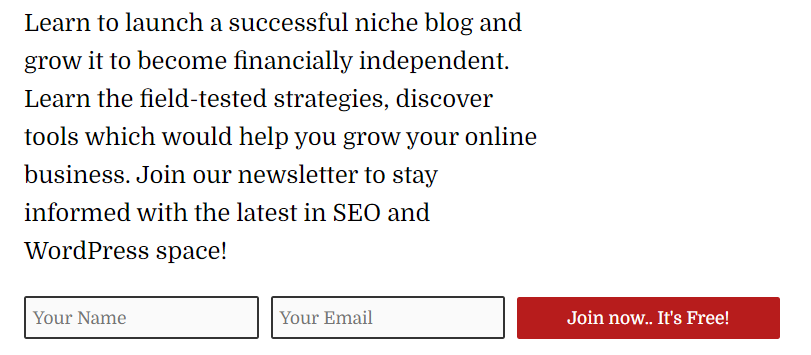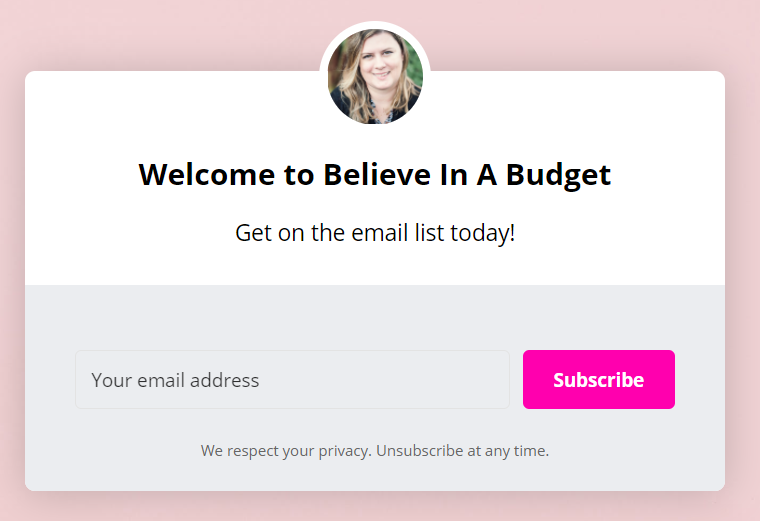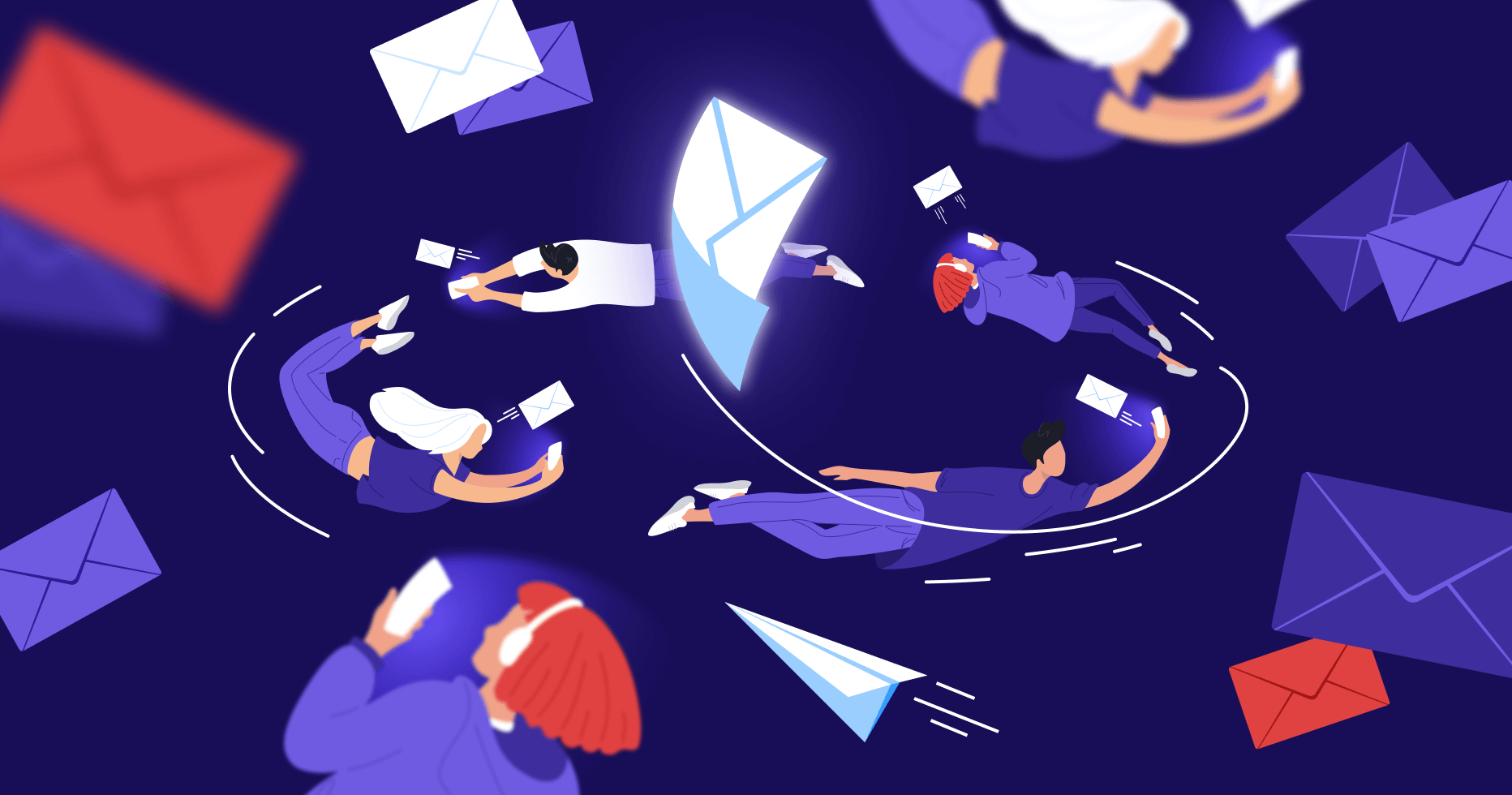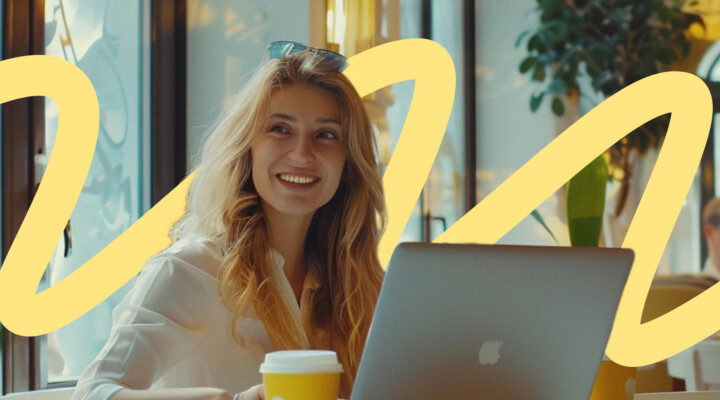Grow Your Email List
To collect as many emails as possible, you need to focus on increasing outreach. You can build an email list for free by placing an appealing subscription form on your site or running promotions on social media.
Add a Subscription Form
First and foremost, you need to place a subscription form on your website. It will capture emails of interested visitors without letting them slip away. The key thing here is to make the form captivating, clearly describe your newsletter content and also keep the number of fields to a minimum.
Forms with too many questions look complicated and long to fill in, which might scare people off. The golden mean is two to three fields, and the rest of the information can be collected upon subscription. Below, there is an example of a concise signup form from the Making Sense of Cents blog.

You can encourage visitors to subscribe by showing social proof, such as your current number of subscribers or social media following, etc. Providing proof that you’re trusted by other people can bring a great increase in signups. The example below is also from the Makes Sense of Cents blog.

It’s also important to clearly describe the value that you’re offering to encourage subscriptions. For example, it can be unique blog materials, invitations to webinars and online meetups, discounts, etc. Check out the example below of a subscription form from the Shout Me Loud blog.

Never Buy Email Lists
Purchasing an email database can be an easy answer to how to grow an email list fast, but it can also harm your reputation and business in many ways. First, such lists are not equal to qualified contacts that would be interested in your business, so both open and engagement rates won’t be high.
Second, this type of contact might feel irritated that they are being approached by a brand they never signed up for and, in turn, mark your email as spam. Email services like Gmail will divert your emails to spam folders if recipients mark them as spam too often, which will reduce the delivery in the long term.
Third, unsolicited emails might also hurt brand awareness, as people will remember your brand name and associate it with intrusive marketing tactics.
Leverage Social Media
Social media is a great means to encourage subscriptions, and it also allows you to build an email list without a website. Schedule posts with appealing visuals on Instagram, Facebook, or other networks. Among other types of content, videos can quickly increase engagement levels with little investment, so be sure to include them into your marketing strategy. Also, don’t forget to add a link to your blog so that those interested could find out more about you and subscribe.
Giveaways and contests are also a surefire way to increase engagement and acquire more leads. What’s more, users are likely to share the contest or giveaway with their friends to get a head start, which will increase your outreach even more.
You can automate the process with social media management tools that will help analyze the audience, schedule posts, and manage several accounts in one interface.
Add CTA Buttons
A clear call to action is a great marketing technique that can make your signup form more visible and increase the number of subscriptions. The button should be easy to see, so it’s better to use a bold or contrasting with the background color. Below, there is an example of a form from the Believe in a Budget blog.

Offer Value
Needless to say, if you want your emails opened and read, it’s important to provide relevant and quality content. Make sure to offer value in every newsletter and also diversify the content you share: it can be news, your blog updates, event invitations, etc. This step naturally requires constant efforts on your part, but this is a sure-fire way to grow an email list organically.
Segment Your Audience
Email marketing list segmentation helps you get closer to your audience by giving them the information they need. Thus, it can bring higher open and click-through rates and, as a consequence, an increase in revenue.
What Is Email List Segmentation
Basically, list segmentation is dividing your email addresses into smaller groups. This process allows you to better target the prospects and provide them with more personalized experience.
To segment your list, you can use different user data such as geography, behavior, professional background, and more. In general, the smaller target groups are, the more personalization you can provide.
When Segmenting Is Important
List segmentation is beneficial in almost any case. There are situations when you’ll want to send mass emails to reach all subscribers at once, for instance, to make an announcement, etc. But in all other cases segmenting only benefits you because it provides the opportunity to target the message better.
Here are some of the advantages of email segmentation:
- Higher open and click-through rates. You can tailor subject and opening lines to entice more clicks.
- More conversions. Put the right offer inside your email to appeal to your audience.
- Less unsubscriptions. The more relevant your offer, the less people unsubscribe from the mailing.
- Avoiding spam filters. By personalizing content, you’ll make it more appealing to the target audience and minimize the chances of them marking your email as spam, which might negatively affect your whole delivery process.
How to Segment Your Email List
Segmentation strategies can vary depending on the size of your business and campaign goals. Smaller companies might choose a couple of differentiators when segmenting their audience, while larger businesses would thoroughly analyze their email list and get granular.
Here are a few email list segmentation examples:
- Industry
- Job title
- Geography
- Gender
- Company size
- Behavior on the internet
- Purchase history
- Customer journey
So, how do you use these criteria for segmentation? For instance, travel bloggers might find it useful to divide their email lists based on geolocation and promote relevant offers for each category. By analyzing web behavior such as clicks or visit stats, you can target particular content to customers, which you know they’ll respond to.
Purchase history will help you understand what products might interest the audience based on their previous bookings. Finally, check where your prospects are in the customer journey and choose content that will move them through the cycle faster.
Once you choose the strategy, it’s time to proceed with list segmentation. Here are the three main steps:
- Define what information will make your marketing more efficient.
- Collect user data. Based on the strategy, start gathering relevant information and focus on optimizing the collection process. For instance, analyze what data points you are already gathering, which ones you need to ask for, and how to do it, like through a survey.
- Create buyer personas. These are aggregated images of your best prospects that help tailor the marketing strategy and choose content that suits them the best. Such images include demographic information, pain points, and goals of prospects, daily routines, etc.
- Prepare content. Once you understand who you’re talking to, start targeting content for each group of customers.
- Use marketing tools to send out emails. While one can segment email lists manually, employing a marketing automation platform can greatly facilitate the process. And besides, many of these tools are free to use if you don’t have a large following.
Clean Your Email List
While you’re striving to grow your list, it might seem strange removing addresses. However, it will only help keep the base relevant and make marketing more efficient. So, if you are already struggling with low engagement or deliverability, email marketing list management might be the right thing to do.
When List Cleaning Can Help
Basically, list cleaning implies removing all irrelevant, duplicate, or disengaged contacts who don’t respond to your emails and could potentially mark them as spam.
How can it help? First, this will increase your engagement rates and thus allow for more meaningful relationships with your audience. Second, by cleaning the list up, you’ll be able to focus on followers who are truly interested and tailor content to their specific needs. Third, this would bring better conversion rates and, as a result, higher income. Finally, lower bounce rates will improve email deliverability and sender reputation for you.
On the other hand, if you don’t clean the list, it will eventually result in higher bounce rate, lower deliverability, and/or spam complaints. All this could affect your sender reputation so mailing providers will direct your emails to users’ spam folders right away.
How to Clean Your Email List
You’ll find a few tactics of how to clean your email list efficiently and improve marketing below.
1.Ask Questions
To understand whether your recipients are still interested in your newsletter, ask them questions and act on the basis of their responses. Here are a few ideas:
- Send a survey or a poll
- Request feedback on some of your content
- Ask to specify preferred topics, mailing frequency, etc.
Once you collect responses from subscribers, filter out those who don’t interact with your emails. What’s more, this step might help you better understand the active part of your audience and tailor the content accordingly.
2. Diversify Content
If the current newsletter doesn’t provide enough engagement, you can take a different approach and diversify email content. For instance, unengaged followers might be attracted to discounts, promo codes, access to exclusive content, etc. Think what strategies you haven’t used yet and deploy them in your mailing.
Some users may find email marketing tiring or boring so they prefer to communicate on social networks or other platforms. Be sure to share your social media profiles and don’t limit marketing to email only.
3. Ask Users to Confirm Subscription
Sometimes people don’t take the effort to unsubscribe and simply ignore emails they are not interested in. In such a case, you can make it easier for everyone by sending a re-subscribe letter and delete those who didn’t opt in.
You can say explicitly that you’ve noticed the lack of engagement and to not clog their mailboxes, you are offering to confirm the subscription in case they still want to receive the newsletter. Be sure to use a clear call to action button so users understand what is required of them. If they don’t respond, simply delete their emails from your database after a couple of weeks.
4. Facilitate Unsubscription
While it’s legally required to let users unsubscribe from mailings, it’s also a good practice to make the process easy. Show followers that you respect their preferences and make the “Unsubscribe” link visible in every email. This will allow unengaged users to opt out and not mark your emails as spam if they aren’t engaging.
Don’t worry that making it easy to leave will hang you out to dry. Quite the opposite, you’ll get an engaged community and could focus on creating relevant content worth sticking around for.
5. Remove Duplicate and Junk Contacts
Your database might have some duplicates, which are a few copies of a single lead. There is no need to keep both of them, but proceed with caution to not confuse contact copies with people who simply have the same name.
Junk contacts are nonexistent emails that people write instead of sharing their real addresses. They can be something like “blah@gmail.com”, etc. To remove bogus addresses, send confirmation letters and ask users to confirm subscriptions to start getting your newsletter.
Marketing automation tools can really help in both cases. Instead of manually checking lead records, you can let the tool filter email addresses and phone numbers. Many CRMs automatically check contacts, but it also makes sense to take an additional look at your list.
Another group of irrelevant contacts are your competitors who might subscribe to your mailing to keep an eye on your marketing strategy. While marketers disagree about what to do in this case, such emails are definitely not leads, so it’s up to you to decide whether they should be affecting your campaign performance.
Use Marketing Automation
With email marketing, there is always a lot on your plate, but the right tools can greatly facilitate the process: from growing email lists to cleaning databases to leveraging social media. Here are a few things that marketing automation allows you to do:
- Send confirmation letters
- Segment audiences
- Nurture leads at all stages of customer journey
- Personalize emails
- Clean mailing lists
- Optimize campaigns easily with click-through data
- Save time and increase efficiency of campaigns
And as a result, you can enjoy many benefits such as higher engagement, increased conversions and revenue, less time spent on marketing, and more.
So, how does it actually work? Basically, you define triggers for the program and it will send the right emails to your contacts at the right time. Such triggers can be viewing a particular product or page, clicks, etc. This can help convert leads as well as improve relationships with existing readers. For example, the tool can identify unengaged subscribers and segment them into a new list so that you can try out other types of content in your newsletter.
Another thing marketing programs can do is cleaning email lists. You simply need to write rules for deleting contacts, for example, ones that are invalid or haven’t opened emails for quite some time.
How to Grow and Segment Your Email List
Now that you’re familiar with the best practices of growing and segmenting your email list, it’s time to put the knowledge to action and make the best of your email marketing campaign. Try to focus on collecting valid contacts that will form an engaged community for your blog. With your email list growing, it’s important to start segmentation and personalize email content to enhance relationships with your audience. And marketing tools can help you at any stage of the process.




